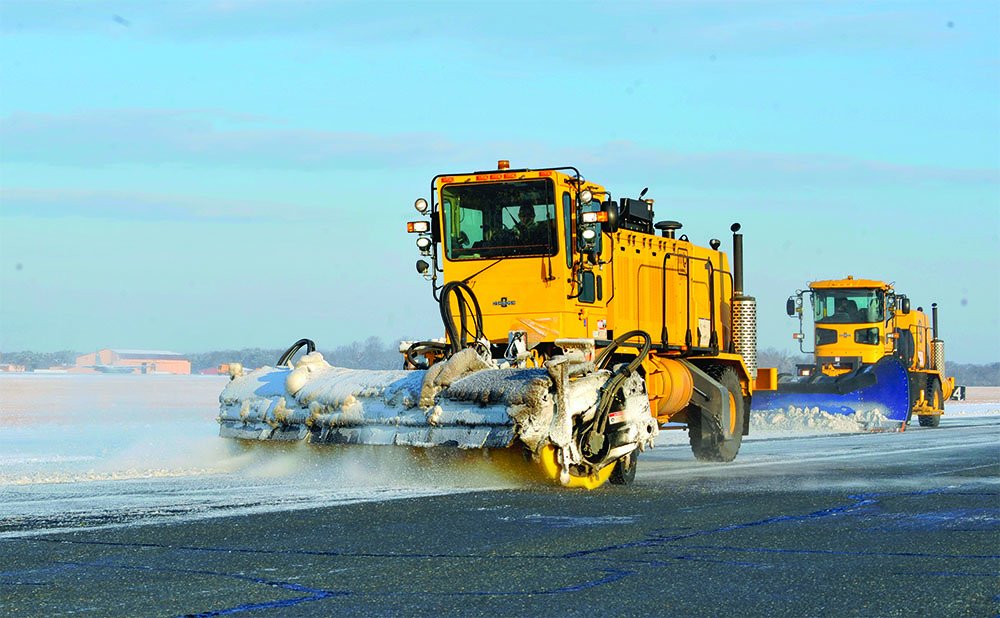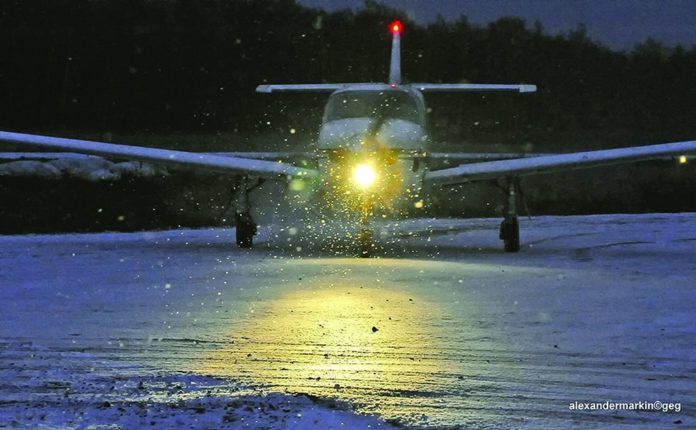Winter has arrived, especially here in the northern latitudes where the snow season is upon us. Y’all living in the south may not have a lot of experience with the stuff. And you may not think you need it. But knowing a bit about snow is a good idea for most of us, if only because a few hours in an airplane easily can transport us from sunny and dry 70-degree comfort to the hidden dangers of the Great White North.
Spend a few moments thinking about it, and you might share my view that snow is a fascinating substance. For example, it can come down in super light flakes with little moisture content, or it can splatter down in a wet slush. Once on the ground, it can it can gently curl away from a dry runway in wisps carried by wing vortices or form hardened berms and crusts capable of shearing off main landing gear and flipping planes on their backs. If nothing else, it’s a good idea for pilots to reflect on which kinds of snow we might encounter, and how it can influence aircraft operations and risk management.
The Science of Snow
As a phenomenon, snow requires moisture to be carried into the atmosphere above freezing level. The type of snow that results depends on the airmass’s moisture content, the amount of lift and the temperature gradient it encounters. Essentially, what we think of as “snow” may be ice crystals formed into individual six-sided snow flakes. But it also can drop from a blue sky as freezing fog, or from a snow squall in dense clumps of flakes. There also are transitional forms spanning the gap between snow and hail, like graupel, a funky rounded opaque 2-5 mm (0.1-0.2 inch) pellet. Graupel forms when snow crystals fall through supercooled cloud liquid water droplets. Pilots may better understand graupel as basically a snow flake that encounters icing conditions on its way to the ground.
Snow events tend to have a higher moisture content as temperatures near the freezing point. The heaviest snowfalls occur when there is relatively warm air (-9 degrees C/15 degrees F) or when it is warmer near the ground. Though it is never too cold to snow, super-cold temperatures tend to produce snows with lower moisture content.
On the ground, snow’s character depends on ground and air temperatures, winds, freeze-thaw cycles and time. As a general rule, snow will not accumulate on the ground if temperatures are above 5 degrees C/41 degrees F. Below this temperature, the first flakes will melt, but the act of melting and cooling from evaporation retards further snow melt and preserves subsequent snowflakes, resulting in accumulation. Once snow accumulates on the ground, it begins to evolve, especially by melting and refreezing. Snow crystals also begin to change, either through wind destruction of crystals, freeze-thaw cycles or sublimation.
Snow that has persisted on the ground for a long time will form crusted layers from wind packing, melting and refreezing. Often the base layer and areas between the crusted layers are hollow. This happens when lighter, fluffy snow consolidates into more dense grain structures. These larger grains, referred to as depth hoar, result from water vapor depositing or desublimating onto existing snow crystals. Granular depth hoar acts like a layer of ball bearings beneath the sheet of frozen crust. Backcountry skiers know this is the stuff avalanches are made of. For pilots, the crusts have a similar catastrophic effect of catching gear or skis resulting in airplanes getting stuck, or worse, getting flipped.
Snow and Ice Removal
Snow in the air or on the ground usually isn’t as operationally important as snow on runways, taxiways or movement areas. While heavy or wind-whipped snowfall can markedly reduce visibility, and snow has been known to affect various aircraft systems, like pitot tubes and engine air intakes, it’s not likely to adhere to an airframe in flight. Snow usually doesn’t become a safety issue until it’s already fallen. The degree to which it remains or is mitigated as a safety factor has everything to do with the speed and quality of snow removal.

According to FAA Advisory Circular AC 150/5200-30C, Airport Winter Safety and Operations, “The presence of contaminants such as snow, ice, or slush on airfield pavements and drifting snow causes hazardous conditions that may contribute to airplane incidents and accidents. Further, winter storm conditions usually reduce airport traffic volumes through flight delays and/or cancellations and, in severe storm conditions, airport closures. The extent to which these undesirable effects are minimized will depend on the approach taken by the airport operator to combat winter conditions.” In a September 18, 2015, press release announcing the fines levied on the City of Cleveland for alleged failure to comply with snow removal regulations, FAA Administrator Michael Huerta said, “Snow and ice removal at our nation’s airports is a critical safety issue.”
Airports certificated under FAR Part 139 (generally, airports with scheduled passenger service) and located where snow and icing conditions occur must “prepare, maintain, and carry out a snow and ice control plan. Many airports have a snow control center (SCC) for managing activities like snow and ice clearing operations, reporting field conditions and informing airport traffic on field or through Notams. When winter hits and you are traveling to a potentially snowy airport, it’s important to pay attention to Notams.
Runway Contamination
Snow on a runway is universally bad. It isn’t always unacceptable, but it is always bad. It reduces friction, reduces contrast, obscures runway markings, and creates or obscures hazards. From a risk management standpoint, snow on the runway (versus taxiways and other movement areas) is the leading cause of snow-related aircraft mishaps. Most mishaps occur during the landing phase, but snow is also known to bite pilots during takeoff and taxi operations.
Before taking the runway, it is always best to wait for snow removal to occur, but not all small unattended airports have that capability. If you are confident you know and understand the ramifications of the snow conditions, you can depart from a snow-covered runway safely. But there’s a big difference between four inches of light, fluffy powder that has remained below freezing and four inches of wet slushy snowpack.
One of the biggest dangers from snow is the effect of wind and freeze-thaw cycles on crust formation. Partially thawed snow isn’t much better. A few inches of slush will impair takeoff acceleration and won’t help braking. Slush can even pose risks after take-off by causing wheels, particularly those in wheel pants or the retractable kind, to freeze. If you have any doubts about takeoff, whatsoever, don’t do it. Takeoffs are always optional.
The best way to understand runway snow contamination is to get out and examine it first hand. If you can do a full-length runway taxi, or even walk the full runway, do it. Sometimes a few passes back and forth will compact the snow and create a clear takeoff path. A runway walk-down is unconventional, but so is departing from a snowy runway. If you must depart, don’t depart in ignorance.
Landing
Landing on a snow-contaminated runway is even more perilous than taking off. Unless you have first-hand experience with the particular runway (like you just departed from it), or have an extremely reliable report on runway conditions from ground crews who know what they’re doing, consider looking for an alternate runway with better snow removal.

If you are heading to a towered airport after snow has fallen, you have the added safety benefit of controllers providing traffic separation for both ground and air operations. If you call in ahead of arrival, the plows will be exiting the field as you line up for final.
If you are traveling to a non-towered airport after a recent snow storm, you may want to call ahead to confirm snow removal has or will occur and find out if snow removal crews will be on CTAF. When breaking out of the clouds on a snowy day in flat light, you want to make sure the runway is clear of both snow and removal equipment before committing to the landing.
If you decide to land, you need to be totally on your game and prepared to abort. This an excellent time to have short- and soft-field techniques in your bag of tricks, short-field because poor braking action can turn a 1000-foot rollout into 2000 feet of slipping and sliding. The slower you land, the faster you will stop. A soft-field technique is handy because if there is a crust, you don’t want the nose wheel to find it until the last possible moment.
Wind and flat light, which affects depth perception and can obscure hidden hazards like snow berms, should be considered. Any wind is challenging when there is lack of friction due to snow and ice. Even if the runway is dry, it doesn’t mean the taxiway is free of snow or ice. Crabbing on an icy taxiway isn’t fun. Trust me on this.
Get-there-itis can be overwhelmingly strong when you arrive at your destination only to find the runway covered by an inscrutable sheet of white. You should always have enough gas to go to an alternate, and a white, snow-covered runway is a more-than-adequate rationale to move on.
Mike Hart is an Idaho-based commercial/IFR pilot and proud owner of a 1946 Piper J3 Cub and a Cessna 180. He also is the Idaho liaison to the Recreational Aviation Foundation.




